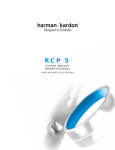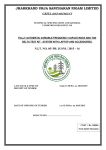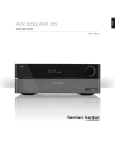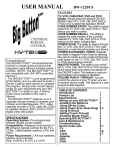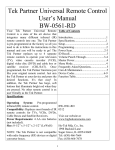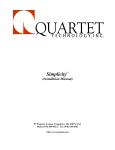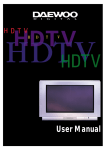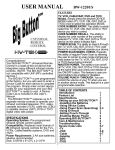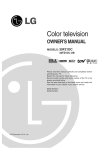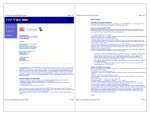Download Harman Kardon RCP 6 User's Manual
Transcript
RCP 6 om.qxd 3/15/07 11:19 AM Page 1 RCP 6 SYSTEM REMOTE OWNER’S MANUAL (FOR USE WITH CP 60 SYSTEM) RCP 6 om.qxd 3/15/07 11:19 AM Page 2 TABLE OF CONTENTS 3 4 8 9 11 11 11 11 12 13 15 15 16 17 17 18 18 18 19 2 INTRODUCTION AND FEATURES REMOTE CONTROL FUNCTIONS BATTERIES PROGRAMMING SOURCES ADVANCED FUNCTIONS Punch-Through Programming Macros Resetting the Remote APPENDIX Remote Control Function List Remote Control Product Codes TV VCR CD DVD SAT TAPE CBL THE BRIDGE/DMP RCP 6 om.qxd 3/15/07 11:19 AM Page 3 INTRODUCTION AND FEATURES Please register your product on our Web site at www.harmankardon.com. Note: You’ll need the product’s serial number. At the same time, you can choose to be notified about our new products and/or special promotions. WWW.HARMANKARDON.COM Thank you for choosing Harman Kardon®! Your CP Series system combines the superior performance and practical flexibility of high-quality separate audio/video components with the convenience of a complete system in one carton. You will need to provide a video display or television, but you may also add almost any source device, ranging from a cassette deck or VCR all the way up to the latest high-definition digital cable or satellite television set-top box (or even products that may be released in the future). The single RCP 6 remote replaces the original remotes supplied with the AVR 247 receiver and DVD 38 DVD player. Although the RCP 6 operates both products, along with a host of other products you may have added to your system, this manual describes a few differences from the original remotes. To obtain the maximum enjoyment from your new home theater system, we urge you to read this manual, as well as the manuals included with the system components, and refer back to it as you become more familiar with its features and their operation. If you have any questions about this product, its installation or its operation, please contact your retailer or custom installer, or visit our Web site at www.harmankardon.com. 3 RCP 6 om.qxd 3/15/07 11:19 AM Page 4 REMOTE CONTROL FUNCTIONS The RCP 6 remote is capable of controlling 11 devices, including the AVR 247 and the DVD 38 included in the CP 60 system. During the installation process, you may program the codes for each of your source components into the remote. Each time you wish to use the codes for any component, first press that component’s selector. This changes the button functions to the appropriate codes for that product. NOTE: Several of the Input Selectors are shared between two devices. The selector button will light in red when the remote is in the device mode printed on the button, and it will light in green for the device mode printed above the button. To switch between the two device modes, press the selector twice quickly in succession. The selector will remain in the last-selected mode until the next time you press it twice quickly. For example, the first time you press the DVD Button, the button will light in red, indicating that the remote is in DVD mode. If you press another selector, such as the VID3 Selector, and then press the DVD Button again, the DVD Button will remain red, indicating the remote is still in DVD mode. Now press the DVD Button twice quickly. At the first press the button will light in red, indicating that the remote is in DVD mode. On the second press the button will turn green, indicating that the remote is now in CD mode. If you press a different selector and return to the DVD/CD Selector, you will observe that the remote is still in CD mode. Each Input Selector has been preprogrammed to control certain types of components, with only the codes specific to each brand and model changing, depending on which product code is programmed. The device types programmed into each selector (except HDMI 1 and 2) may not be changed. is not already playing. 3. Press the Skip Up Button three times to advance three tracks. 4. Press the AVR Button so that you can access the volume controls. 5. Press the Volume Down Button until the volume level is satisfactory. Any given button may have different functions, depending on which component is being controlled. The buttons are labeled with some of these functions, with the receiver’s functions shown in gray, and the DVD player’s functions shown in blue. For example, the Sleep and DSP Surround Buttons are labeled for use as Channel Up/Down Buttons when controlling a television or cable box. See Table A1 in the Appendix for listings of the different functions for each type of component. NOTE: Although we have described the applicable DVD functions in this section, we strongly recommend that you review the DVD 38 manual for more information about using these functions. IR Transmitter Lens: As buttons are pressed on the remote, infrared codes are emitted through this lens. Make sure it is pointing toward the component being operated. Power On Button: Press this button to turn on the AVR or another device. The Master Power Switch on the AVR 247’s front panel must be switched on first. Mute Button: Press this button to mute the AVR 247’s speaker and headphones outputs temporarily. To turn off muting, press this button or adjust the volume. Muting is also canceled when the receiver is turned off. DVD: Controls DVD players and recorders. The DVD Button functions Program Indicator: This LED lights up or flashes in one of three colors are labeled in blue on the remote. as the remote is programmed with codes. CD: Controls CD players and recorders. Tape: Controls cassette decks. The Bridge/DMP: Controls an iPod® docked in The Bridge. Video 1: Controls VCRs, TiVo® and DVRs. Video 2: Controls cable and satellite television set-top boxes. Video 3: Controls televisions and other video displays. Video 4: Controls a TV connected to the front-panel inputs. HDMI 1 and 2: Each code set controls a source device (such as Power Off Button: Press this button to turn off the AVR 247 or another device. AVR Selector: Press this button to switch the remote to the codes that operate the receiver. Input Selectors: Press one of these buttons to select a source device, which is a component where a playback signal originates (e.g., DVD, CD, cable TV, satellite or HDTV tuner). This will also turn on the receiver (if it is not already on) and switch the remote’s mode to operate the source device. a VCR/PVR, DVD player or cable/satellite set-top box) connected to one of these two inputs. AM/FM Button: Press this button to select the tuner as the source, XM: Controls the AVR functions for XM® Satellite Radio. 6-/8-Channel Input Selector: Press this button to select the 6-/8-Channel Inputs as the audio source. The receiver will use the video input and remote control codes for the last-selected video source. For example, if you have inserted a disc in your CD player and you would like to skip ahead three tracks, but you then find that the volume is too loud, you would follow this procedure: 1. Press the CD Input Selector to switch to the codes that control your CD player. If the remote is in DVD mode, press the selector twice quickly to switch to CD mode, indicated by the selector turning green. 4 2. Press the Play Button (in the Transport Controls section) if the disc or to switch between the AM and FM bands. XM Radio Button: Press this button to select XM Satellite Radio as the source. You will need to have purchased and activated an XM antenna module, and you will also need to subscribe to the XM Satellite Radio service. Visit www.xmradio.com for more information. RCP 6 om.qxd 3/15/07 11:19 AM Page 5 IR Transmitter Lens Power On Program Indicator Mute Power Off Input Selectors AVR Selector AM/FM XM Radio Test Tone 6-/8-Channel Input Selector TV/Video/Video Off Sleep/Audio Select Volume Controls DSP Surround/Title On-Screen Display/Disc Info Multiroom/HD Mode Speaker Setup/DVD Setup Channel Level/Disc Menu Navigation Set/Enter Digital Input Select/ Drawer Open/Close Delay/DVD Status Numeric Keys Memory/Playlist Clear Tuning Mode/Zoom Direct Station Entry/Angle Tuning Preset Stations Selectors Disc Skip/Audio Mode Macros Tone Mode/DVD Scan Type DTS® Surround/A-B Repeat Dolby® Surround DTS Neo:6® Surround Stereo Modes/Repeat Logic 7® Surround/Random Dim Night Mode/Subtitle Track Skip Transport Controls Record ® NOTE: To make it easier to follow the instructions throughout the manual that refer to this illustration, a copy of this page may be downloaded from the Product Support section at www.harmankardon.com. 5 RCP 6 om.qxd 3/15/07 11:19 AM Page 6 REMOTE CONTROL FUNCTIONS Test Tone Button: Press this button to activate the test tone for manual output-level calibration. TV/Video/Video Off Button: This button has no effect on the receiver, but is used to switch video inputs on some video source components. When the DVD player has been selected (by pressing the DVD Input Selector), pressing this button disables the DVD 38’s video output to avoid “burning in” menus or still images on sensitive video displays. This feature is particularly useful when listening to CDs or other audio-only presentations. Sleep/Audio Select Button: Press this button to activate the sleep timer, which shuts off the receiver after a programmed period of up to 90 minutes. When the DVD player has been selected, this button may be used to select another audio format or language, if one is available on the disc. Volume Controls: Press these buttons to raise or lower the volume, which will be shown in decibels (dB) in the Message Display. DSP Surround/Title Button: Press this button to select a DSP Surround mode (Hall 1, Hall 2, Theater). When the DVD player has been selected, this button serves the Title function. When a DVD is playing, press this button to go back to the main title menu for the disc. If you are playing a DVD-Audio disc that contains other audio formats, such as linear PCM or Dolby® Digital 5.1, pressing this button may enable you to switch playback from one audio format to another. On-Screen Display (OSD)/Disc Info Button: Press this button to activate the AVR 247’s on-screen menu system. When the DVD player has been selected, this button serves the Disc Info function. Press it once to access the Player Information menu for information on the current disc and the playback mode settings. This function is different from the Disc Menu and DVD Setup functions. Multiroom/HD Mode: Press this button to control the multiroom system. Three settings are available: MULTI ON/OFF, which is used to turn the multiroom system on or off; MULTI LEVEL, which adjusts the volume of the remote zone; and MULTI INPUT, which is used to select the source input for the remote zone. See Multiroom Operation in the Advanced Functions section of the AVR 247 manual for more information on using the multiroom system. When the DVD player has been selected, this button serves the HD Mode function, which is available when the DVD 38’s HDMI™ output is used. Pressing this button enables you to select a lower resolution than the maximum your video display is capable of handling, as determined by the “handshake” procedure between the DVD 38 and AVR 247 and your video display. See the DVD 38 owner’s manual for more information on HDMI and the HD Mode Selector. Channel Level/Disc Menu: Press this button to set the output levels for each channel so that all speakers sound equally loud at the listening position. This may be done while playing an audio selection, such as a favorite CD, after you have calibrated the levels using EzSet/EQ.™ 6 When the DVD player has been selected, this button serves the Disc Menu function. While a disc is playing, press this button to view the disc’s menu. This function is different from the Disc Info and DVD Setup functions. Speaker Setup/DVD Setup: Press this button to configure speaker sizes, that is, the frequency-range capability of each speaker. This may be done using the on-screen menu system, as described in the Advanced Functions section of the AVR 247 owner’s guide. When the DVD player has been selected, this button serves the DVD Setup function. Press it to use the DVD 38’s on-screen menu system to adjust the player’s configuration settings. This function is different from the Disc Info and Disc Menu functions. Navigation and Set Buttons: These buttons are used together to make selections within the AVR 247’s or DVD 38’s on-screen menu system, or when accessing the AVR functions of the four buttons surrounding this area of the remote – Channel Level, Speaker Setup, Digital Input or Delay. Digital Input Select/Drawer Open/Close: Press this button to select the specific digital audio input (or analog audio input) you used for the current source. When the DVD player has been selected, this button is used to open or close the disc drawer. Delay/DVD Status: Press this button to set delay times that compensate for placing the speakers at different distances from the listening position, or to resolve a “lip sync” issue that may be caused by digital video processing. This may also be done using the on-screen menu system, as described in the Advanced Functions section of the AVR 247 owner’s guide. When the DVD player has been selected, this button serves the DVD Status function. Press it while a DVD is playing to view the on-screen Status Bar, which will display the current title and chapter, the Play Mode icon and the elapsed time, in addition to a “temperature bar” display of the time elapsed. The Status Bar may be navigated as described in the DVD 38 manual. Numeric Keys: Use these buttons to enter radio station frequencies or to select station presets. When the AM or FM band is in use, press the Direct Button before entering the station frequency. When listening to XM Radio, you may enter channel numbers without first pressing the Direct Button; however, to access the preset stations, you will need to use the Preset Stations Selectors. To access another bank of XM presets, press the Set Button repeatedly until PRESET SEARCH appears, then use the ⁄/ ¤ Buttons to select the letter of the desired bank. Tuning Mode/Zoom: When listening to AM or FM radio, this button toggles between Manual (one frequency step at a time) and Automatic (seeks frequencies with acceptable signal strength) Tuning modes. It also toggles between Stereo and Mono modes when an FM station is tuned. When listening to XM Radio, press the Tuning Mode Button once to view the category name of the current channel. Additional presses will display the artist, song title and channel name. RCP 6 om.qxd 3/15/07 11:19 AM Page 7 REMOTE CONTROL FUNCTIONS When the DVD player has been selected, this button performs the Zoom function. Press it to zoom in on a DVD, VCD or JPEG image. The image may be enlarged by a factor of 2x, 3x, 4x or 5x. Once the on-screen indication of the zoom ratio disappears from the screen, you may use the Navigation Buttons to explore the picture. Memory/Playlist: After you have tuned a particular radio station, press this button, then a Numeric Key, to save that station as a radio preset. For XM Radio, the procedure for saving a preset is a little different. To save the current channel in one of the 40 available preset locations, press the Set Button repeatedly until PRESET SEARCH appears. Use the ⁄/ ¤ Buttons to select a letter (A through E) representing one of the five banks of preset memory slots. Then press the Memory Button, followed by a Numeric Key (1 through 8) for the precise preset memory location you wish to save the channel in. When the DVD player has been selected, this button performs the Playlist function, which enables you to change the order in which tracks or chapters are played. Tuning: Press these buttons to tune a radio station or XM Radio channel. For the AM and FM bands, and depending on whether the tuning mode has been set to Manual or Automatic, each press will either change one frequency step at a time, or seek the next frequency with acceptable signal strength. Direct Station Entry/Angle: Press this button before using the Numeric Keys to directly enter a radio station frequency (AM or FM bands only). When the DVD player has been selected, this button is used for the Angle function. Press it during passages on a DVD where the director has programmed multiple camera angles to view the alternate perspectives. When a JPEG file is on-screen, each press of this button rotates the image by 90 degrees clockwise. Clear: Press this button to clear a radio station frequency you have started to enter. When the DVD player has been selected, this button may be used to clear any on-screen displays from view. In addition, press and hold it for five seconds to reset all user settings on the DVD 38 to their factory defaults. Preset Stations Selectors: Press these buttons to select a preset radio station. For XM Radio, first press the Set Button repeatedly until PRESET SEARCH appears, and then use the ⁄/ ¤ Buttons to select the letter of the desired bank of presets. Tone Mode/DVD Scan Type: Press this button to access the tone controls (bass and treble). Use the Navigation Buttons to make your selections. When the DVD player has been selected, this button adjusts the Video Scan Type setting for the component video outputs. Each press toggles between progressive and interlaced scanning. This button is useful if you inadvertently set the scan type to progressive when your video display or television is not capable of displaying progressively scanned video. Although your video display may be distorted, you may restore interlaced scanning by pressing this button. Disc Skip/Audio Mode: This button has no effect on the AVR 247, but is used with some optical disc changers to skip to the next disc. When the DVD 38 is in use, each press of this button cycles through the three Bass Management settings, which may also be adjusted using the AUDIO SETUP menu: Bypass, On and Stereo. The Bypass and On settings are used with the 6-Channel Analog Audio Outputs to bypass or activate the DVD 38’s speaker settings. With either of these settings, only the front left and right channel information will be available at the DVD 38’s 2-Channel Analog Audio Outputs, rather than a downmix that includes the center and surround information as well. The Stereo setting is used when a two-channel downmix is desired. The downmix will be available at both the 2-Channel Analog Audio Outputs and the front left and right jacks of the 6-Channel Analog Audio Outputs. However, the center and surround jacks of the 6-Channel Analog Audio Outputs will be silent. Macros: These buttons may be programmed to execute long command sequences with a single button press. They are useful for programming the command to turn on or off all of your components, or for accessing specialized functions for a different component than the one you are currently operating. Dolby Surround Mode Selector: The first press of this button will select the last-used Dolby Surround mode, and each additional press will cycle through the variants that are currently available. Not all modes are available with all sources; see the AVR 247 manual for more information. DTS® Surround Mode Selector/A-B Repeat: The first press of this button will select the last-used DTS Digital mode if DTS processing is available, and each additional press will toggle between the 2.0, 5.1 and DTS-ES® variants. See the AVR 247 manual for more information. When the DVD player has been selected, this button serves the A-B Repeat function. The first press while a disc is playing selects the beginning of the passage you wish to repeat, and the second press selects the end of the passage. The selected passage will play continuously until the A-B Button is pressed a third time, or play is stopped. DTS Neo:6® Surround Mode Selector: The first press of this button will select the last-used DTS Neo:6 Surround mode if it is available, and each additional press will cycle through the variants that are currently available. See the AVR 247 manual for more information. Logic 7® Surround Mode Selector/Random: The first press of this button will select the last-used Logic 7 Surround mode if it is available, and each additional press will cycle through the Cinema, Music and Enhance modes. See the AVR 247 manual for more information. 7 RCP 6 om.qxd 3/15/07 11:19 AM Page 8 REMOTE CONTROL FUNCTIONS When the DVD player has been selected, this button serves the Random function. When a CD is playing and no playlist is active, each press of this button turns random track selection on or off. Night Mode/Subtitle: Press this button to activate Night mode When the DVD player has been selected, each press of this button cycles through the available Repeat modes, excluding A-B Repeat. Track Skip: These buttons have no effect on the receiver, but are used with the DVD 38 and many other source components to change tracks or chapters. with specially encoded Dolby Digital discs or broadcasts. Night mode compresses the audio so that louder passages are reduced in volume to avoid disturbing others, while dialogue remains intelligible. Dim: Press this button to partially or fully dim the AVR 247’s or When the DVD player has been selected, this button performs the Subtitle function. Press it to select a subtitle language or to turn subtitles off. Transport Controls: These buttons have no effect on the receiver NOTE: Due to the variations in how DVD discs are authored, the subtitle languages displayed by the DVD 38 may not accurately reflect the actual languages available on the disc. It is recommended that subtitles be selected using the disc’s menu. DVD 38’s front-panel display. but are used to control the DVD 38 and many other source components. By default, when the remote is operating the receiver, these buttons will control the DVD 38. Record: This button has no function on the AVR 247 or DVD 38. It is used with many audio and video recorders. Stereo Modes/Repeat: The first press of this button will select the last-used Stereo mode, which may be Surround Off or Two-Channel Processing. Each additional press will toggle between Surround Off, 5-Channel Stereo and 7-Channel Stereo. When an analog audio source is in use and the AVR 247’s Tone Mode control has been set to Out, you may also select Analog Bypass mode, which passes the analog input signal to the volume control, bypassing digital signal processing. See the AVR 247 manual for more information. BATTERIES The RCP 6 remote control uses three AAA batteries, which are included. To remove the battery cover located on the back of the remote, firmly press the ridged depression and slide the cover toward the top of the remote. Insert the batteries as shown in Figure 1, making sure to observe the correct polarity. When using the remote, remember to point the lens toward the front panel of the AVR 247 or DVD 38. Make sure no objects, such as furniture, are blocking the remote’s path. Bright lights, fluorescent lights and plasma video displays may interfere with the remote’s functioning. The remote has a range of about 20 feet, depending on the lighting conditions. It may be used at an angle of up to 30 degrees to either side of the component. If the remote seems to operate intermittently, or if pressing a button on the remote does not cause the AVR Selector or one of the Input Selectors to light up, then make sure the batteries have been inserted correctly, or replace all three batteries with fresh ones. Figure 1 – Remote Battery Compartment 8 RCP 6 om.qxd 3/15/07 11:19 AM Page 9 PROGRAMMING SOURCES Programming Sources The RCP 6 remote is capable of controlling not only the receiver and DVD player included in your CP system, but it may also be programmed to control many brands and models of VCRs, CD players, cable boxes, satellite receivers, cassette decks and TVs, as well as an iPod (not included) docked in Harman Kardon’s optional The Bridge. It may help to think of the remote as a book with pages. Each page represents the button functions for a different device. To access the functions for a particular device, you first need to turn to that page, that is, switch the remote to that device mode. This is done by pressing the AVR Button to access the codes that control the receiver, or the Input Selectors to access the codes for the devices programmed into the remote. c) HDMI 1 Source: Press and hold the Input Selector until the selector relights and the Program Indicator flashes, then release it. Next, press the Input Selector that corresponds to the device type you want to program into the HDMI 1 mode, i.e., DVD, VCR or CBL/SAT. Follow the directions in Step 4. d) HDMI 2 Source: Press and release the Input Selector once, then quickly press the Input Selector again so that it turns green, then release it. Now press and hold the Input Selector until the selector relights and the Program Indicator flashes, then release it. Next, press the Input Selector that corresponds to the device type you want to program into the HDMI 2 mode, i.e., DVD, VCR or CBL/SAT. Follow the directions in Step 4. You may have noticed that three of the Input Selectors look different from the others (see Figure 2). For the DVD/CD, TAPE/The Bridge and HDMI 1/HDMI 2 Selectors, there is a primary source, whose name is printed on the button, and a secondary source, whose name is printed above the button. When the remote is in the device mode for the primary source (e.g., DVD) pressing the device selector will cause it to light in red. When the remote is in the secondary source’s device mode, the selector will light in green when pressed. To switch between the primary and secondary device modes, press the selector twice quickly in succession. The selector will retain this selection until the next time you toggle between the primary and secondary device modes. That is, if you press the DVD/CD Selector twice quickly so that the CD source is activated, then press another source selector, such as Video 1, the next time you press the DVD/CD Selector, the remote will return to the CD device mode. The RCP 6 remote is factory-programmed to control the AVR 247, the DVD 38 and an iPod docked in The Bridge. If you have other source devices in your system, such as a VCR, or a cable or satellite television set-top box, follow these steps to program the correct codes into the remote: 1. Using the codes in Tables A2–A9 of the Appendix, look up the product type (e.g., cable TV box) and the brand name of your source. The number(s) listed are potential candidates for the correct code set for your particular device. 2. Turn on your source device. 3. This step places the remote in Program mode and varies slightly, depending on which Input Selector is being programmed. Refer to Figure 2. a) DVD, Tape, Video 1, Video 2, Video 3 and Video 4 Sources: Press and hold the Input Selector until the Program Indicator LED starts to flash, then release it. Follow the directions in Step 4. Figure 2 – Input Selectors 4. Enter a code from Step 1 above. a) If the device turns off, then press the Input Selector again to accept the code; the selector will flash. The remote will exit the Program mode. b) If the device does not turn off, try entering another code. If you run out of codes, you may search through all of the codes in the remote’s library for that product type by pressing the ⁄ or ¤ Button repeatedly until the device turns off. When the device turns off, enter the code by pressing the Input Selector, which will flash. The remote then exits Program mode. NOTE: When you enter a valid three-digit code, the Program Indicator LED will change color to green. However, entering an invalid code changes the color of the LED to red. 5. Once you have accepted a code, it’s a good idea to try using some other functions to control the device. Sometimes manufacturers use the same power code for several different models, while other codes will vary. You may wish to repeat this process until you’ve programmed a satisfactory code set that operates most of the functions you frequently use. 6. You may find out which code number you have programmed by pressing and holding the Input Selector to enter Program mode. Then press the Set Button, and the LED will flash in the code sequence. One flash represents “1”, two flashes for “2” and so forth. A series of many fast flashes represents “0”. Record the codes programmed for each device in Table 1. b) CD Source: Press the DVD/CD Input Selector twice quickly so that it turns green, then hold it until the selector relights and the Program Indicator flashes. Follow the directions in Step 4. 9 9 RCP 6 om.qxd 3/15/07 11:19 AM Page 10 PROGRAMMING SOURCES Table 1 – Remote Control Codes Source Input Video 1 Video 2 Video 3 Video 4 HDMI 1 HDMI 2 DVD * CD Tape Product Type (circle one) VCR, PVR Cable, Satellite TV TV DVD, VCR/PVR, Cable, Satellite DVD, VCR/PVR, Cable, Satellite DVD CD, CD-R Cassette Remote Control Code * Do not reprogram the DVD Source Selector unless you are replacing the DVD player included in the CP 60 system with another product. If you are unable to locate a code set that correctly operates your source device, it will not be possible to use the RCP 6 remote to control that device. However, you may still connect the source to the AVR 247 and operate it using the device’s original remote control. Most of the button labels on the remote describe the button’s function when used to control the AVR 247 (gray labels) or DVD 38 (blue labels). However, the button may perform a very different function when used to control another device. Refer to the Remote Control Function List, Table A1 in the Appendix, for a list of each button’s functions with the various product types. If you wish, you may program macros, which are preprogrammed code sequences that execute many code commands with a single button press. You may also program “punch-through” codes, which allow the remote to operate the volume, channel or transport controls of another device without having to switch the remote’s device mode. See page 12 for instructions on these advanced programming functions. NOTE: The RCP 6 remote is preprogrammed to operate the transport controls of the DVD 38 when the AVR or VID2 or VID3 device is selected. You may change this punch-through programming at any time, as explained in the Advanced Functions section. 10 10 RCP 6 om.qxd 3/15/07 11:19 AM Page 11 ADVANCED FUNCTIONS The RCP 6 remote control not only operates the AVR 247 and DVD 38, but it also serves as a universal remote that may be programmed to operate many of your other home theater components. The punchthrough and macro features add even more flexibility and versatility. Punch-Through Programming The RCP 6 remote allows you to select one component for the remote to operate, while simultaneously setting certain groups of controls to operate another component. For example, while using the remote to control video functions on your TV, you may wish to use your cable box to change channels and the AVR to control the volume. This is possible using punch-through programming. NOTE: It is not necessary to program the remote to control your DVD player’s transport controls while the AVR or a device connected to the VID2 or VID3 inputs is in use, as the remote is preprogrammed at the factory with this function. To program punch-through control while operating any device: 1. Press and hold the Input Selector (or AVR Selector) for the main device the remote will be operating until the Input Selector lights, the Program Indicator LED flashes and the remote enters Program mode. 2. Select the type of punch-through programming: If you wish to reprogram these selectors to have no transportcontrol punch-through, follow the same procedure as for programming punch-through, but in Step 3 press either of the other two of these three selectors. For example, to remove transport-control punch-through from the VID2 device, follow the instructions in Steps 1 through 3, but press either the AVR or VID3 Button in Step 3. Macros Macros are used to program sequences of up to 19 commands that are executed with a single button press. Macros are well-suited for Power On and Off commands, to send out a favorite multidigit channel number with one button press, or to have the ability to send out a code sequence to control another device while the remote is operating one device but with more flexibility than the built-in punchthrough controls. Some commands may not be programmed into macros: Mute, Dim, Channel Up/Down and any of the Surround Mode commands. NOTE: Use caution when programming complicated macros. It isn’t possible to program a pause or delay before sending commands after powering on, and the component may not be ready to respond to commands instantaneously after powering on. To program, or “record,” a macro, follow these steps: a) To program volume control punch-through, press the Volume Up Button. 1. Simultaneously press one of the four Macro Buttons or the Power On Button and the Mute Button at the same time to enter Program mode. b) To program channel control punch-through, press the Volume Down Button. 2. Press the Input (or AVR) Selector for each device before you enter commands to be transmitted to that device. This step counts as one of the 19 commands allowed for each macro. NOTE: Do not program channel-control punch-through for the AVR. Doing so will override the Sleep command, which is not accessible in any other way, and the DSP Surround Mode Selector. If you have inadvertently done so, repeat Steps 1 through 3, but press the AVR Selector in both Steps 1 and 3. c) To program transport control punch-through, press the Play Button. NOTE: Even if you previously switched one of the dual-source Input Selectors (DVD/CD, TAPE/THE BRIDGE, HDMI 1/HDMI 2) to the primary or secondary source prior to programming the macro, the remote always requires you to press any of these selectors once to program the macro to select the primary source and twice for the secondary source. 3. Press the Input Selector (or AVR Selector) for the device whose volume, channel or transport controls you would like to be active while operating the device you selected in the first step. The LED will flash green to confirm the programming. 3. For the Power On command, do not press the Power On Button. Press the Mute Button instead. For example, if you wish to watch your TV (programmed into the Video 3 Button) while changing channels using your cable box (Video 2), first press the Video 3 Button until the LED flashes. Then press the Volume Down Button, followed by the Video 2 Button. 5. Press the Sleep Button to end the programming process. To undo punch-through programming, follow the same steps as above, but press the same Input (or AVR) Selector in Steps 1 and 3. NOTE: The AVR, VID2 and VID3 devices are factory-programmed with transport-control punch-through to operate the DVD player. You may reprogram these selectors following the instructions in Steps 1 through 3 to operate another device, such as a CD player. 11 4. Press the Power Off Button to program the Power Off command. It isn’t possible to “edit” a command within a macro. However, you may erase the macro as follows: 1. Simultaneously press and hold the Mute Button and the Macro Button containing the macro until the Program LED flashes. 2. Press the Surround Button to erase the macro. Resetting the Remote To reset the remote to its factory defaults, simultaneously press and hold any Input Selector and the “0” Numeric Key. When the LED flashes amber, enter the code “333”. When the green LED goes out, the remote will have been fully reset. 11 RCP 6 om.qxd 3/15/07 11:19 AM Page 12 APPENDIX Refer to the numbered buttons in this drawing when using the Function List. Figure 3 – Remote Control Function List Reference 12 RCP 6 om.qxd 3/15/07 11:19 AM Page 13 APPENDIX Table A1 – Remote Control Function List No. Button Name AVR Function DVD CD/CD-R Tape VCR (VID1) Power On Power On Power On (AVR) Power On TiVo (VID1) CBL (VID2) SAT (VID2) TV (VID3/VID4) Power On/Off Power On Power On Power On The Bridge TM (DMP) XM HDMI 1/2 1 Power On Power On 2 Power Off Power Off Power Off Power Off Power Off (AVR) Power Off TV Power Power Off Power Off Power Off Power Off (AVR) Power Off (AVR) Power Off 3 Mute Mute Mute (AVR) Mute (AVR) Mute (AVR) Mute Mute Mute Mute Mute (AVR) 4 AVR AVR Select AVR Select AVR Select AVR Select AVR Select AVR Select AVR Select AVR Select AVR Select AVR Select AVR Select AVR Select 5 DVD/CD DVD Input Select DVD Select DVD Select DVD Select DVD Select DVD Select DVD Select DVD Select DVD Select DVD Select DVD Select DVD Input Select 6 Tape/ The Bridge TM Mute Power On (AVR) Power On (AVR) Power On Mute (AVR) Mute CD Input Select CD Select CD Select CD Select CD Select CD Select CD Select CD Select CD Select CD Select CD Select CD Input Select Tape Select Tape Select Tape Select Tape Select Tape Select Tape Select Tape Select Tape Select Tape Select Tape Select Tape Select Tape Select The Bridge (DMP) Select The Bridge (DMP) Select The Bridge (DMP) Select The Bridge (DMP) Select The Bridge (DMP) Select The Bridge (DMP) Select The Bridge (DMP) Select The Bridge (DMP) Select The Bridge (DMP) Select The Bridge (DMP) Select The Bridge (DMP) Select The Bridge (DMP) Select 7 HDMI 1/HDMI 2 HDMI 1 Select HDMI 1 Select HDMI 1 Select HDMI 1 Select HDMI 1 Select HDMI 1 Select HDMI 1 Select HDMI 1 Select HDMI 1 Select HDMI 1 Select HDMI 2 Select HDMI 2 Select HDMI 2 Select HDMI 2 Select HDMI 2 Select HDMI 2 Select HDMI 2 Select HDMI 2 Select HDMI 2 Select HDMI 2 Select HDMI 2 Select HDMI 2 Select Video 1 Select VCR Select VCR Select VCR Select VCR Select VCR Select VCR Select VCR Select VCR Select VCR Select VCR Select VCR Select 8 VID 1 (VCR) 9 VID 2 (CBL/SAT) Video 2 Select CBL/SAT Select CBL/SAT Select CBL/SAT Select CBL/SAT Select CBL Select SAT Select CBL/SAT Select CBL/SAT Select CBL/SAT Select CBL/SAT Select Video 3 Select TV Select TV Select TV Select TV Select TV Select TV Select TV Select TV Select TV Select TV Select TV Select 11 VID 4 Video 4 Select TV Select TV Select TV Select TV Select TV Select TV Select TV Select TV Select TV Select TV Select TV Select 12 XM XM Select XM Select XM Select XM Select XM Select XM Select XM Select XM Select XM Select XM Select XM Select XM Select 13 AM/FM Tuner Select Tuner Select Tuner Select Tuner Select Tuner Select Tuner Select Tuner Select Tuner Select Tuner Select Tuner Select Tuner Select Tuner Select 14 6/8CH 6/8 Ch. Input Select 6/8 Ch. Input Select 6/8 Ch. Input Select 6/8 Ch. Input Select 6/8 Ch. Input Select 6/8 Ch. Input Select 6/8 Ch. Input Select 6/8 Ch. Input Select 6/8 Ch. Input Select 6/8 Ch. Input Select 6/8 Ch. Input Select 6/8 Ch. Input Select 16 Test Tone Audio V. OFF Input Select Volume Up Volume Up 18 Vol Up Volume Up 19 Surr/Title DSP Surround Mode Select Title 20 OSD/Info OSD Disc Info 21 M-Room/HD Multiroom HD Mode 22 Vol Down Channel + Channel + TV/VCR TV Input TV/CBL TV/SAT Channel + Channel + TV/VCR Volume Up TV/Video Volume Up Volume Up CDR Select Channel – Channel – Channel – Channel – Channel – Channel – OSD Live TV OSD OSD OSD OSD Volume Down Volume Down Volume Down Disc Menu Continuous Play 24 Speaker/Setup Speaker Setup Setup Intro Scan 25 Channel + Program 23 CH./Disc Menu Channel Trim ⁄ Channel + Test Tone 17 T/V/V.Off Menu Guide Guide Info Menu Menu Menu Volume Down Volume Down Menu Menu Volume Down Guide Menu Move/Adjust Up Up Up Up Up Up Up Up Up 26 fi Move/Adjust Left Left Left Left Left Left Left Scroll – Left Left 27 Set Set Enter Enter Select Enter Enter Enter Select Set Set/Enter 28 fl Move/Adjust Right Right Right Right Right Right Right Scroll + Right Right Down Down Down Down Down Down Down 29 ¤ Move/Adjust Down Down 30 Digital/Open/Close Digital Input Select Open/Close 13 HDMI 1 Select 10 VID 3 (TV) 15 Sleep/Audio Sleep CBL/SAT Select HDMI 1 Select Open/Close Return/Exit 31 Delay/Status Delay Adjust Status Prev Channel Prev Channel Prev Channel 32 1 1 1 1 1 1 1 1 1 1 Prev. Channel 1 33 2 2 2 2 2 2 2 2 2 2 2 34 3 3 3 3 3 3 3 3 3 3 3 35 4 4 4 4 4 4 4 4 4 4 4 36 5 5 5 5 5 5 5 5 5 5 5 37 6 6 6 6 6 6 6 6 6 6 6 38 7 7 7 7 7 7 7 7 7 7 7 39 8 8 8 8 8 8 8 8 8 8 8 13 RCP 6 om.qxd 3/15/07 11:19 AM Page 14 APPENDIX Table A1 – (continued) No. Button Name AVR Function DVD CD/CD-R Tape VCR (VID1) TiVo (VID1) CBL (VID2) SAT (VID2) TV (VID3/VID4) The Bridge TM (DMP) XM HDMI 1/2 40 Tun-M/Zoom Tuning Mode Zoom Repeat 41 9 9 9 9 9 9 9 9 9 9 9 42 0 0 0 0 0 0 0 0 0 0 0 Playlist Time 43 Memory/Playlist Memory 44 Tuning Up Tuning Up Random Play 46 Clear Clear Clear 47 Preset Up Preset Tune Up Clear Cancel Cancel FAV/Angle Clear Clear +10 48 Tuning Down Tuning Down Tone Mode Memory Track Direct 45 Direct/Angle Direct Tuner Entry Angle 49 Tone/P/I Tuning Mode Sleep Tuning Up FAV Angle/FAV Next Clear Alt Preset Up Track Increment P/I Tuning Down Program Tone Mode 50 D. Skip/Audio Disc Skip (DVD) Audio Mode Disc Skip Tone Mode Tone Mode Tone Mode Skip 51 Preset Down Preset Down Preset Down 52 M1 Macro 1 Macro 1 Macro 1 Macro 1 Macro 1 Macro 1 Macro 1 Macro 1 Macro 1 Macro 1 Macro 1 Macro 1 53 M2 Macro 2 Macro 2 Macro 2 Macro 2 Macro 2 Macro 2 Macro 2 Macro 2 Macro 2 Macro 2 Macro 2 Macro 2 54 M3 Macro 3 Macro 3 Macro 3 Macro 3 Macro 3 Macro 3 Macro 3 Macro 3 Macro 3 Macro 3 Macro 3 Macro 3 55 M4 Macro 4 Macro 4 Macro 4 Macro 4 Macro 4 Macro 4 Macro 4 Macro 4 Macro 4 Macro 4 Macro 4 Macro 4 56 Dolby Surround Dolby Modes 57 DTS/A-B DTS Digital Modes A-B Repeat 58 DTS Neo:6 DTS Neo:6 Select 59 Night/Subtitle Night Mode Select Subtitle On/Off 60 Logic 7/Random Logic 7 Select CDP Select Random 61 Stereo/Repeat Stereo Mode Select Repeat 62 Skip Down Skip – (DVD) Step – Skip – Scan – Thumbs Down Skip – (DVD) Skip – (DVD) Skip – (DVD) 63 Skip Up 64 Dim Skip + (DVD) Step + Skip + Scan + Thumbs Up Skip + (DVD) Skip + (DVD) Skip + (DVD) Dimmer Dimmer Rewind 65 Rewind (‹‹ ) R. Search (DVD) R. Search/Slow R. Search Rewind R. Search R. Search (DVD) R. Search (DVD) R. Search (DVD) Skip–/R. Search R. Search 66 Play (‹›) Play (DVD) R. Play/F. Play Play Play Play (DVD) Play Play 67 Fast-Forward ( ››) F. Search (DVD) F. Search/Slow F. Search Fast Fwd F. Search F. Search (DVD) F. Search (DVD) F. Search (DVD) Skip+/F. Search 68 Record Record Record/Pause Record Stop Play Play 69 Stop Stop (DVD) Stop Stop 70 Pause Pause (DVD) Pause Pause Fast Fwd Play (DVD) Play (DVD) Record F. Search Record Stop Slow Stop (DVD) Stop (DVD) Stop (DVD) Pause Pause Pause (DVD) Pause (DVD) Pause (DVD) Stop Pause Pause NOTE: When any of the transport controls are pressed while the remote is in AVR, Video 2 or Video 3 mode, the remote will automatically switch to DVD mode and the command will be applied to the DVD player. If you then press a button native to the original mode, e.g., Volume Down for the AVR, the remote will revert to the original mode. See Punch-Through Programming, as described in the Advanced Functions section, for more information. 14 RCP 6 om.qxd 3/15/07 11:19 AM Page 15 APPENDIX Refer to Tables A2 through A9 when programming the codes for your components into the remote. Table A2 – Remote Control Product Codes – TV TV Manufacturer/Brand A MARK ADMIRAL AIWA AKAI AMPRO ANAM AOC BLAUPUNKT BROKSONIC CANDLE CAPEHART CENTRONIC CENTURION CITIZEN CLASSIC CONCERTO CONTEC CORANDO CORONADO CRAIG CROWN CURTIS MATHES CXC DAEWOO DAYTRON DIGILINK DYNASTY DYNATECH ELECTROHOME EMERSON FUNAI FUTURETECH GE GOLDSTAR/LG GRUNDIG HALL MARK HARMAN KARDON HITACHI INFINITY INKEL JBL JC PENNEY JENSEN JVC KAWASHO KEC KENWOOD KMC KTV LLOYTRON 15 Setup Code Number 122 132 192 027 123 160 164 045 106 109 112 122 123 128 084 205 206 123 128 059 045 123 171 045 123 128 132 045 128 045 172 132 045 157 158 159 045 132 123 128 132 045 045 087 102 105 127 128 132 128 132 200 045 063 115 132 045 123 128 132 045 045 029 087 121 123 101 110 122 128 193 128 201 123 128 132 147 148 120 148 115 123 128 132 019 079 087 134 173 045 123 204 132 045 123 132 162 172 173 122 106 108 111 114 116 119 139 157 158 159 162 205 128 133 145 159 163 132 145 TV Manufacturer/Brand LODGENET LOGIK LUXMAN LXI MAGNAVOX MARANTZ MATSUI MEMOREX METZ MGA MINERVA MITSUBISHI MTC NATIONAL NEC NIKEI ONKING ONWA OPTONICA ORION PANASONIC PHILCO PHILIPS PIONEER PORTLAND PROSCAN PROTON QUASAR RADIO SHACK RCA REALISTIC RUNCO SAA SAMPO SAMSUNG SANYO SCOTT SEARS SHARP SIEMENS SIGNATURE SONY SOUNDESIGN SPECTRICON SSS SYLVANIA SYMPHONIC TANDY TATUNG TECHNICS TECHWOOD Setup Code Number 069 069 128 077 145 148 030 123 128 132 115 123 148 148 069 128 084 115 123 128 084 077 115 123 128 175 176 148 177 179 180 115 121 123 125 045 045 045 077 207 208 209 210 087 148 169 045 115 123 128 033 034 035 036 024 123 128 128 132 133 059 122 128 132 032 087 045 128 132 180 021 115 123 128 045 167 196 152 153 183 059 123 128 020 022 124 128 026 054 045 128 132 128 132 145 077 128 132 084 069 028 031 117 130 045 128 122 045 025 123 128 145 184 077 063 181 128 145 148 160 167 168 181 182 211 132 148 123 128 132 145 148 165 196 197 133 145 161 163 132 145 136 194 212 148 15 RCP 6 om.qxd 3/15/07 11:19 AM Page 16 APPENDIX Table A2 (continued) Table A3 (continued) TV Manufacturer/Brand TEKNIKA TELERENT TERA THOMSON TMK TOSHIBA TOTEVISION VIDEO CONCEPTS VIDTECH WARDS YAMAHA YORK YUPITERU ZENITH ZONDA VCR Manufacturer/Brand MARANTZ MEMOREX MGA MITSUBISHI MULTITECH NAD NATIONAL NEC NORDMENDE OPTIMUS ORION PANASONIC PHILCO PHILIPS PORTLAND PULSAR QUASAR RADIO SHACK RCA REALISTIC SALORA SAMSUNG SANSUI SANYO SCOTT SEARS SHARP SONY SOUNDESIGN SYLVANIA SYMPHONIC TANDY TASHICO TATUNG TEAC TEKNIKA THOMAS TiVo TMK TOSHIBA TOTEVISION UNITECH VECTOR RESEARCH VIDEO CONCEPTS VIDEOSONIC WARDS YAMAHA ZENITH Setup Code Number 045 069 115 123 128 132 069 156 190 191 128 063 129 202 132 160 128 069 128 132 148 123 128 128 045 069 090 122 Table A3 – Remote Control Product Codes – VCR VCR Manufacturer/Brand AIWA AKAI AMPRO ASA AUDIO DYNAMICS BROKSONIC CANDLE CANON CAPEHART CITIZEN CRAIG DAEWOO DAYTRON DBX DYNATECH EMERSON FISHER FUNAI GE GO VIDEO GOLDSTAR/LG HARMAN KARDON HITACHI JC PENNEY JENSEN JVC KENWOOD LLOYD LXI MAGIN MAGNAVOX 16 Setup Code Number 040 048 108 109 126 076 134 018 048 110 147 134 135 135 140 094 134 045 116 017 094 104 094 018 048 040 013 040 042 110 112 017 040 076 095 124 113 018 107 002 003 018 049 040 048 018 045 048 018 048 111 132 020 048 040 020 040 045 040 Setup Code Number 018 017 020 040 052 049 049 131 040 139 140 018 048 048 159 147 125 150 167 172 040 040 075 094 076 001 125 055 134 140 142 095 124 125 157 017 020 040 045 020 045 051 095 105 048 116 147 017 020 110 112 017 020 129 156 080 129 040 040 040 017 040 134 048 040 048 040 040 004 005 006 007 013 112 155 045 045 018 018 040 045 040 045 112 018 040 048 040 050 076 083 053 054 076 158 159 172 159 109 008 009 010 012 RCP 6 om.qxd 3/15/07 11:19 AM Page 17 APPENDIX Table A4 – Remote Control Product Codes – CD Table A4 (continued) CD Manufacturer/Brand ADCOM AIWA AKAI AUDIO TECHNICA AUDIOACCESS AUDIOFILE BSR CALIFORNIA AUDIO CAPETRONIC CARRERA CARVER CASIO CLARINETTE DENON EMERSON FISHER FRABA FUNAI GE GENEXXA GOLDSTAR/LG HAITAI HARMAN KARDON HITACHI INKEL JC PENNEY JENSEN JVC KENWOOD LOTTE LUXMAN LXI MAGNAVOX MARANTZ MCINTOSH MCS MITSUMI MODULAIRE NAD NAKAMICHI NEC NIKKO ONKYO OPTIMUS PANASONIC PHILIPS PIONEER PROTON QUASAR RADIO SHACK RCA CD Manufacturer/Brand RCX REALISTIC SANSUI SANYO SCOTT SHARP SHERWOOD SONY Setup Code Number 063 069 072 111 118 156 050 177 184 053 125 211 044 109 070 087 136 140 141 143 117 166 166 187 188 213 052 093 108 055 095 117 126 164 108 016 087 099 214 001 002 025 054 093 216 098 147 153 176 195 196 030 062 078 079 108 077 102 164 039 113 058 084 191 192 194 080 098 152 166 013 074 197 198 199 200 201 069 053 055 037 038 045 046 065 089 091 092 075 109 119 158 039 138 149 209 071 094 100 112 210 109 126 166 213 024 081 093 150 170 144 145 185 186 SOUNDSTREAM SYMPHONIC TAEKWANG TEAC THETA DIGITAL TOSHIBA VECTOR RESEARCH VICTOR WARDS YAMAHA YORK 190 148 151 176 178 181 193 171 175 202 203 099 104 212 183 204 123 131 161 162 215 Setup Code Number 169 058 093 095 104 047 081 134 157 033 082 095 108 058 105 114 151 003 041 058 105 103 115 116 118 208 212 217 124 059 110 177 011 058 085 086 154 039 013 074 097 151 087 120 130 095 019 031 053 061 166 105 108 164 166 172 159 167 180 181 133 132 139 163 205 206 207 106 107 110 121 137 146 155 173 135 169 Table A5 – Remote Control Product Codes – DVD DVD Manufacturer/Brand APEX DIGITAL DENON GE GOLDSTAR/LG HARMAN KARDON JVC MAGNAVOX MARANTZ MITSUBISHI NAD ONKYO PANASONIC PHILIPS PIONEER PROCEED PROSCAN RCA SAMSUNG SHARP SONY THOMSON TOSHIBA YAMAHA ZENITH Setup Code Number 061 019 051 003 004 005 055 064 066 001 002 007(Default) 068 006 056 059 023 062 009 048 024 030 044 056 041 065 060 003 004 003 004 053 054 028 043 045 003 004 009 058 067 030 063 005 055 064 17 RCP 6 om.qxd 3/15/07 11:19 AM Page 18 APPENDIX Table A6 – Remote Control Product Codes – SAT Table A7 – Remote Control Product Code – TAPE SAT Manufacturer/Brand Setup Code Number TAPE Manufacturer/Brand Setup Code Number HARMAN KARDON 001 ALPHASTAR ALPHASTAR DBS ALPHASTAR DSR BIRDVIEW CHANNEL MASTER CHAPARRAL CITOH DRAKE DX ANTENNA ECHOSTAR ELECTRO HOME FUJITSU GENERAL INSTRUMENT HITACHI DBS HOUSTON TRACKER HUGHES JANIEL JERROLD KATHREIN LEGEND MACOM MAGNAVOX MEMOREX NEXTWAVE NORSAT OPTIMUS PACE DSS PANASONIC PANASONIC DBS PANSAT PERSONAL CABLE PHILIPS PICO PRESIDENT PRIMESTAR RCA RCA DSS REALISTIC SAMSUNG SATELLITE SERVICE CO SCIENTIFIC ATLANTA SONY STAR CHOICE DBS STARCAST SUPER GUIDE TEECOM TOSHIBA UNIDEN ZENITH 18 472 450 442 425 320 315 360 313 331 395 392 324 303 455 463 437 366 454 410 453 317 461 453 423 373 466 487 366 457 420 418 375 407 381 412 301 458 349 442 335 339 405 459 347 327 330 302 323 389 384 Table A8 – Remote Control Product Codes – CBL 321 325 361 316 451 CBL Manufacturer/Brand Setup Code Number 317 318 413 481 352 379 483 397 452 453 463 477 478 484 485 329 334 311 323 365 403 454 468 474 489 468 484 365 369 370 371 473 469 404 454 468 475 439 465 490 480 388 423 333 426 332 403 385 390 460 348 466 387 391 461 349 479 394 393 409 462 350 351 354 355 381 383 480 419 488 ABC ALLEGRO AMERICAST ARCHER BELCOR CABLE STAR CITIZEN COLOUR VOICE DIGI EAGLE EASTERN ELECTRICORD EMERSON FOCUS G.I. GC ELECTRONICS GEMINI GENERAL GENERAL INSTRUMENT GOODMIND HAMLIN HITACHI JASCO JERROLD LINSAY MACOM MAGNAVOX MOVIE TIME NSC OAK PACE PANASONIC PANTHER PHILIPS PIONEER POPULAR MECHANICS PRELUDE PRIMESTAR RADIO SHACK RCA RECOTON REGAL REMBRANT SAMSUNG 001 111 212 112 113 033 111 085 114 186 066 039 112 116 001 113 032 210 210 112 056 001 111 001 118 191 017 035 035 197 179 053 114 013 001 116 120 162 111 053 116 056 032 003 011 113 090 070 011 017 096 097 060 099 100 101 117 175 208 188 002 011 017 073 096 097 162 188 210 019 068 039 190 220 176 177 189 214 019 020 085 090 041 119 171 209 215 216 112 213 214 099 100 101 208 072 186 RCP 6 om.qxd 3/15/07 11:19 AM Page 19 APPENDIX Table A8 (continued) CBL Manufacturer/Brand Setup Code Number SCIENTIFIC ATLANTA SEAM SIGNATURE SPRUCER STARCOM STARGATE TANDY TELECAPATION TEXSCAN TFC TIMELESS TOCOM UNITED CABLE UNIVERSAL VIDEOWAY VIEWSTAR ZENITH ZENTEK 183 121 001 053 002 120 024 028 036 122 123 170 011 033 124 019 065 116 203 221 222 188 081 177 189 011 163 205 034 039 042 113 211 025 086 089 190 125 211 219 Table A9 – Remote Control Product Codes – THE BRIDGE/DMP DMP Manufacturer/Brand Setup Code Number HARMAN KARDON TEN TECHNOLOGIES 001 002 Harman Kardon and Logic 7 are trademarks of Harman International Industries, Incorporated, registered in the United States and/or other countries. Designed to Entertain and EzSet/EQ are trademarks of Harman International Industries, Incorporated. Dolby is a registered trademark of Dolby Laboratories. DTS, DTS Neo:6 and DTS-ES are registered trademark of DTS, Inc. HDMI (High-Definition Multimedia Interface) is a trademark of HDMI Licensing LLC. iPod is a registered trademark of Apple Inc. TiVo is a registered trademark of TiVo Inc. XM is a registered trademark of XM Satellite Radio. 19 RCP 6 om.qxd 3/15/07 11:19 AM Page 20 250 Crossways Park Drive, Woodbury, New York 11797 www.harmankardon.com © 2007 Harman International Industries, Incorporated. All rights reserved. Part No. CQX1A1210Z




















